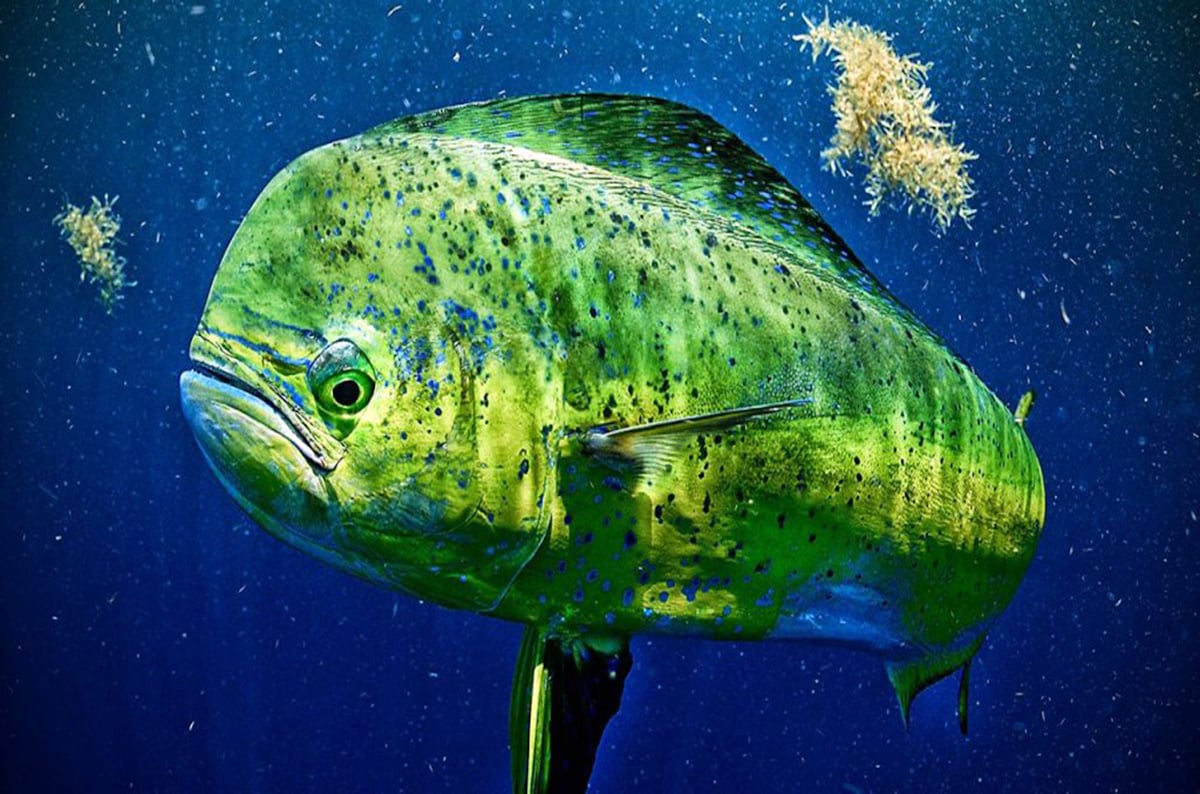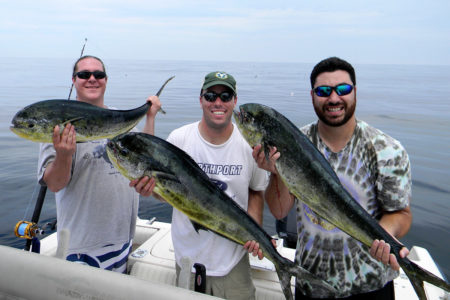Highly prized as a recreational gamefish, mahi-mahi grow fast and have saved the day on more than a few bluewater trips.
Dolphinfish (Coryphaena hippurus), also known as mahi-mahi, mahi, dorado, dolphinfish, dolphin, common dolphin fish and green dolphin are sometimes confused with the marine mammal bearing the same name; that confusion is in the name only. Mahi-mahi are large, green fish, and a dolphin, like “Flipper” are mammals. They are completely unrelated but often confused by non-fishermen.
They are found in tropical and subtropical waters around the world. This odd shaped fish has a long body, and a blunt face. It looks like it swam into a wall once too many times. Mahi-mahi have a forked tail fin, and a dorsal fin that runs the length of the body that has this fish designed for speed. It is bright colored, mostly golden-green and blue that fades to a yellow to white underside, and irregular blotches of metallic blues and greens on its back and sides.
Dolphinfish are found in offshore warm waters and are attracted to sargassum, a seaweed that floats and serves as a hiding place and hunting ground for dolphin. As shallow continental shelf waters start to warm in the summer, mahi-mahi moves closer to shore and are occasionally seen within 10 miles of the shoreline. They are also found near the coast, ranging in depths from 0 to 279 feet of water. Small mahi travel together in schools from a few fish to over 50, while larger fish often travel by themselves, or in pairs.

Mahi are known to reach a maximum of 6 feet in length, but more commonly to lengths of 3 feet. They are often caught up to 30 pounds, but some areas produce fish to 50 and even 60 pounds. The world record mahi-mahi is 87 pounds. Sexual maturity is reached in four to five months, and spawning first occurs at approximately 8 inches in length. Dolphin grow rapidly throughout their life, with a maximum life span of about 4 years, according to the Florida Museum of Natural History (FMNH).
Their spawning season is lengthy, and multiple spawnings per year are common in both males and females. Dolphin spawn in pairs, rather than communally, with spawning occurring year-round in the tropics. In the northern and southern extremes of the range, they apparently spawn only in the warmer months. Larvae are found in tropical waters worldwide. Young dolphin are found in the Florida Current year round, but peak abundance occurs in the summer.
Larvae hatch at approximately 4 mm total length, and reach a length of 5.7 mm within four days. At 15 days, the larvae are approximately 15 mm long. Vague adult characteristics are visible at this size, and the eyes and mouth are fully developed. Juvenile dolphins are marked with a pattern of alternating dark and light bars at 10 to 20 mm in length. As the juveniles grow, these bars become more obscure, and are non-existent in many individuals.
Mahi-mahi are opportunistic hunters, and will feed on a variety of prey according to season and size of the fish. They feed during the day on small fish including flying fish, ballyhoo, mackerel, sardines and triggerfish. They have also been known to eat shrimp, squid and crabs, as well as juveniles of large pelagic fish such as tuna, billfish, jacks and even smaller members of their own species. They also feed on pelagic larvae of bottom dwelling fish such as flying gunard, triggerfish, pufferfish, and grunts.
In the Atlantic Ocean, true albacore tuna, yellowfin tuna and blue marlin are predators of mahi. They are frequently observed with holes pierced through them by marlin bills. Blue marlin, black marlin, yellowfin tuna, and sailfish are common predators of the dolphinfish.
This fish is highly prized both as a recreational gamefish and are also sought after commercially. Anglers typically take advantage of the mahi’s attraction to floating objects and setting up under mats of wees, bunches of bamboo reeds, planks and other surface debris. They are highly valued as a food fish, low in saturated fat and a good source of vitamin B12, phosphorus, and potassium. They are also a very good source of protein, niacin, vitamin B6, and selenium.
Mahi-mahi from Maine to Florida are managed through the South Atlantic Fishery Management Council’s (SAFMC) Dolphin Wahoo Fishery of the Atlantic Fishery Management Plan (FMP) in cooperation with the Mid-Atlantic and New England Councils.




